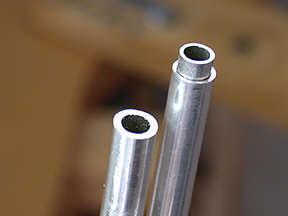Tube Setting Basics
Tube-setting is a stylish way to set round gemstones, and its a great first step toward more complex gemstone setting. Fabricating bezels to accommodate faceted gemstones of different shapes and sizes is an advanced skill to aspire to; however, tube-setting can more easily fulfill the desire to include faceted gemstones in your designs. Here you will learn how to tube-set a faceted gemstone using thick-walled tubing or using two telescoping tubes.
5 Minute Read
Tube setting is a stylish way to set round gemstones, and it's a great first step toward more complex gemstone setting. Fabricating bezels to accommodate faceted gemstones of different shapes and sizes is an advanced skill to aspire to; however, tube setting can more easily fulfill the desire to include faceted gemstones in your designs. Here you will learn how to tube set a faceted gemstone using thick-walled tubing or using two telescoping tubes.
Round, faceted gemstones come in many sizes, usually measured across the diameter in millimeters. Unlike gemstones, tubing is limited in size variations. Tubing can be reduced in diameter by following the same principles as drawing down wire.
Tube Setting with Telescoping Tubes
Telescoping tubes describe a smaller piece of tubing sliding within a larger tube for a tight fit.
Make sure the gemstone fits properly — sitting tight and straight — in the larger tubing, with the smaller tubing supporting it from inside. Saw through both pieces of tubing, one inside the other, to get the height correct, leaving some height for sanding. Sand the inner tubing shorter if needed, checking the height until it allows the gemstone to sit in the tubing with the crown facets projecting above the bezel lip. As with thick-walled tubing, the goal is to use as little metal as possible to hold the stone.
Depending on the project you have selected, either solder the tubes to a back plate with one inside the other, or solder them together. Cut a seat with a setting bur to take off the flat edge on the inside tubing and provide the correct angle for the pavilion facets of the gemstone to sit without the risk of chipping them. Set the gemstone in the same way as shown in steps 3-13 for thick-walled tubing.
Custom Fit Tubing by Drawing it Down
If your tubing is too large for your purpose — either to hold a gemstone or to telescope inside another piece of tubing — use a draw plate to draw it down. Anneal the section of tubing you want to make smaller. Saw a 1-in. (25.5mm) slice of the wall away from one end of the tubing. Start a saw cut in the middle of the tubing end, and angle your cut to taper toward one wall.
Use roundnose pliers to crimp in the edges of the tubing.
Insert the crimped end of the tubing into the tapered side of a draw plate until it protrudes at least 1⁄2 in. (13mm) out of the narrow side. Grip the protrusion with draw tongs or heavy-duty pliers, and pull the tubing through the draw plate.
Check it for fit with your gemstone or with the other piece of tubing. Repeat this process, using progressively smaller holes on the draw plate, until your tubing is the size you want it. Be careful not to jump any holes in the draw plate; tubing draws down very quickly, and you can easily overshoot your goal.
Materials
- Faceted gemstones
- Silver tubing
Tools & Supplies
- Gauges: brass slide or degree
- Flex shaft, setting burs, drill bits
- Beeswax
- Jeweler's saw, 2/0 blades
- Tube-cutting jig
- Sandpaper, various grits
- Soldering materials: copper tongs, flux, pickle, soldering pad, solders, torch
- Bezel burnisher, pusher, and rocker
- Polishing equipment or equivalent flex shaft burs and mandrels
- Draw plates (optional)
- Roundnose pliers (optional)
- Draw tongs or heavy-duty pliers (optional)
You assume all responsibility and risk for the use of the safety resources available on or through this web page. The International Gem Society LLC does not assume any liability for the materials, information and opinions provided on, or available through, this web page. No advice or information provided by this website shall create any warranty. Reliance on such advice, information or the content of this web page is solely at your own risk, including without limitation any safety guidelines, resources or precautions, or any other information related to safety that may be available on or through this web page. The International Gem Society LLC disclaims any liability for injury, death or damages resulting from the use thereof.
The All-In-One Jewelry Making Solution At Your Fingertips
When you join the Ganoksin community, you get the tools you need to take your work to the next level.
Trusted Jewelry Making Information & Techniques
Sign up to receive the latest articles, techniques, and inspirations with our free newsletter.
